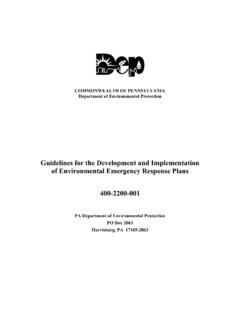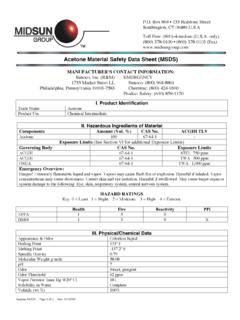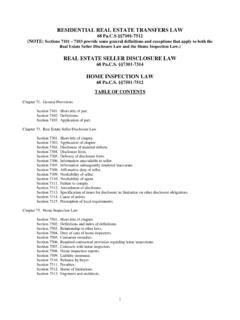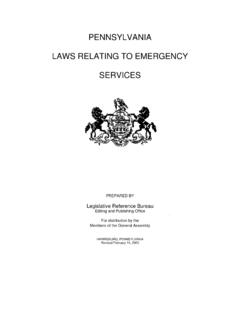Transcription of SHIPPING OF TECHNOLOGICALLY ENHANCED ... - …
1 SHIPPING OF TECHNOLOGICALLY ENHANCED naturally occurring radioactive material UNDER THE DOT hazardous material TRANSPORTATION REGULATIONS Safe and proper shipment of radioactive materials occurs routinely on pennsylvania roads. This includes nuclear medicine materials, industrial test equipment and manufactured products. This fact sheet focuses on the shipment of TECHNOLOGICALLY ENHANCED naturally occurring radioactive material (TENORM). Most soils and rocks contain some level of naturally occurring radioactive material (NORM). This NORM is often affected by physical or chemical actions resulting in TENORM. Examples of TENORM-containing materials include fire brick, water and wastewater treatment residuals (sludge), and decorative polished rock ( , granite and marble) commonly used in building or home construction.
2 It is also common for the native rock formations encountered by the oil and gas (O&G) extraction industry during drilling to contain levels of NORM, specifically uranium, thorium and their decay products. Consequently, drill cuttings from these formations may be classified as TENORM. In addition, sediment, water and wastewater residuals, sludges and solid filter cakes resulting from the recycling or processing of produced water ( , brines or flowback) may also contain TENORM. This fact sheet is intended to alert generators of TENORM-containing materials in all industry sectors that, at high concentrations, the TENORM may be classified as a hazardous material as defined by the Department of Transportation (USDOT). The USDOT has regulatory authority and responsibility for safety in the transportation of all hazardous materials, including radioactive material .
3 There are nine hazardous material classifications, with radioactive material being Class 7. FEDERAL REGULATION It is important to note that this fact sheet is not intended to provide complete guidance on the packaging and shipment of radioactive material under USDOT hazardous Materials Regulations (HMR) contained in Title 49, Code of Federal Regulations (49 CFR) Parts 100-178. However, the first step when moving materials is to determine if levels of radioactive materials meet the USDOT HMR definition of Class 7 radioactive material , as defined in 49 CFR In the case of radium-226 (Ra-226), for example, any shipment that is offered for transport in commerce having a Ra-226 concentration greater than 270 picocuries per gram and a total activity above microcuries would be subject to the USDOT HMR regulations.
4 If those thresholds are met, then the other USDOT HMR regulations related to proper shipment name ( , low specific activity), manifesting as hazardous material on SHIPPING papers, proper packaging, and marking and placarding as radioactive must be evaluated and implemented. TENORM EVALUATION In addition to radioactive material concentration and total activity data, the physical characteristics of the material must be determined if there is more than one hazard class material being transported. The TENORM in the material has to be fully characterized by proper sampling, radiochemistry and/or in situ gamma spectroscopy. The Department of Environmental Protection (DEP) cautions the O&G industry when SHIPPING based on indirectly measuring of external gamma radiation fields from the material .
5 The state of equilibrium between the radioactive materials and respective decay products, when measured less than 25 days, does not result in an accurate assessment. It is the responsibility of each person that offers a hazardous material for transportation in commerce to develop methods of sampling, testing and monitoring radioactive materials in the product or waste. This may require a series of sampling radiochemistry laboratory tests and routine exposure rate measurements from the SHIPPING package to determine if the upper limits of activity and concentration are exceeded. If high concentrations of TENORM are expected from a process, DEP recommends that a qualified USDOT HMR shipper and Commonwealth of pennsylvania Department of Environmental Protection 2900-FS-DEP4374 Rev.
6 12/2014 health physicist be engaged to evaluate the radioactive material concentration in the material to be shipped. USDOT HMR Class 7 radioactive Placard Reference: USDOT regulations online at For regulatory questions about the shipment of natural material , ores or hazardous material transportation requirements, contact: DEP Bureau of Radiation Protection Box 8469 Harrisburg, PA 17105-8469 Office: 717-787-2480 Fax: 717-783-8965 For more information, visit , keyword: Radiation Protection.











